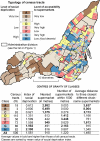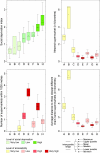The case of Montréal's missing food deserts: evaluation of accessibility to food supermarkets
- PMID: 17295912
- PMCID: PMC1803774
- DOI: 10.1186/1476-072X-6-4
The case of Montréal's missing food deserts: evaluation of accessibility to food supermarkets
Abstract
Background: Access to varied, healthy and inexpensive foods is an important public health concern that has been widely documented. Consequently, there is an increasing interest in identifying food deserts, that is, socially deprived areas within cities that have poor access to food retailers. In this paper we propose a methodology based on three measures of accessibility to supermarkets calculated using geographic information systems (GIS), and on exploratory multivariate statistical analysis (hierarchical cluster analysis), which we use to identify food deserts in Montréal.
Results: First, the use of three measures of accessibility to supermarkets is very helpful in identifying food deserts according to several dimensions: proximity (distance to the nearest supermarket), diversity (number of supermarkets within a distance of less than 1000 metres) and variety in terms of food and prices (average distance to the three closest different chain-name supermarkets). Next, the cluster analysis applied to the three measures of accessibility to supermarkets and to a social deprivation index demonstrates that there are very few problematic food deserts in Montréal. In fact, census tracts classified as socially deprived and with low accessibility to supermarkets are, on average, 816 metres away from the nearest supermarket and within 1.34 kilometres of three different chain-name supermarkets.
Conclusion: We conclude that food deserts do not represent a major problem in Montréal. Since geographic accessibility to healthy food is not a major issue in Montréal, prevention efforts should be directed toward the understanding of other mechanisms leading to an unhealthy diet, rather than attempting to promote an even spatial distribution of supermarkets.
Figures




Similar articles
-
Mapping the evolution of 'food deserts' in a Canadian city: supermarket accessibility in London, Ontario, 1961-2005.Int J Health Geogr. 2008 Apr 18;7:16. doi: 10.1186/1476-072X-7-16. Int J Health Geogr. 2008. PMID: 18423005 Free PMC article.
-
Do 'food deserts' influence fruit and vegetable consumption?--A cross-sectional study.Appetite. 2005 Oct;45(2):195-7. doi: 10.1016/j.appet.2005.04.003. Appetite. 2005. PMID: 15927303
-
Measuring food access in Melbourne: access to healthy and fast foods by car, bus and foot in an urban municipality in Melbourne.Health Place. 2007 Dec;13(4):877-85. doi: 10.1016/j.healthplace.2007.02.005. Epub 2007 Apr 30. Health Place. 2007. PMID: 17470408
-
[The concept and measurement of food security].J Prev Med Public Health. 2008 Nov;41(6):387-96. doi: 10.3961/jpmph.2008.41.6.387. J Prev Med Public Health. 2008. PMID: 19037168 Review. Korean.
-
Food industry and economic development in the Asia Pacific.Asia Pac J Clin Nutr. 2007;16 Suppl 1:80-4. Asia Pac J Clin Nutr. 2007. PMID: 17392081 Review.
Cited by
-
Building non-motorized accessible communities for heterogeneous demand: A facility location and network design problem.PLoS One. 2024 Oct 17;19(10):e0312230. doi: 10.1371/journal.pone.0312230. eCollection 2024. PLoS One. 2024. PMID: 39418275 Free PMC article.
-
Lessons from COVID-19 pandemic: Analysis of unequal access to food stores using the Gini coefficient.Cities. 2023 Apr;135:104217. doi: 10.1016/j.cities.2023.104217. Epub 2023 Jan 20. Cities. 2023. PMID: 36694616 Free PMC article.
-
Comparing alternative approaches to measuring the geographical accessibility of urban health services: Distance types and aggregation-error issues.Int J Health Geogr. 2008 Feb 18;7:7. doi: 10.1186/1476-072X-7-7. Int J Health Geogr. 2008. PMID: 18282284 Free PMC article.
-
Food deserts in Winnipeg, Canada: a novel method for measuring a complex and contested construct.Health Promot Chronic Dis Prev Can. 2017 Oct;37(10):350-356. doi: 10.24095/hpcdp.37.10.05. Health Promot Chronic Dis Prev Can. 2017. PMID: 29043762 Free PMC article.
-
Is proximity to a food retail store associated with diet and BMI in Glasgow, Scotland?BMC Public Health. 2011 Jun 10;11:464. doi: 10.1186/1471-2458-11-464. BMC Public Health. 2011. PMID: 21663674 Free PMC article.
References
-
- Beaumont J, Lang T, Leather S, Mucklow C. Report from the policy sub-group to the nutrition task force low income project team of the Department of health. Radlett , Institute of Grocery Distribution; 1995.
-
- Reisig V, Hobbiss A. Food deserts and how to tackle item: A study of one city's approach. Health Education Journal. 2000;59:137–149.
-
- Bertrand L. Colloque annuel de l'OMISS (Observatoire montréalais des inégalités sociales de santé) Montréal, Canada ; 2002. Les inégalités sociales de l’alimentation à Montréal.
-
- Wrigley N. Food deserts in British cities: Policy context and research priorities. Urban Stud. 2002;39:2029–2040. doi: 10.1080/0042098022000011344. - DOI
Publication types
MeSH terms
LinkOut - more resources
Full Text Sources

